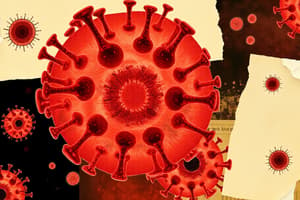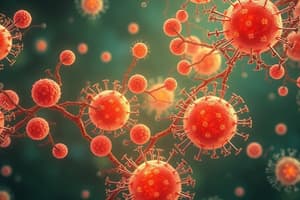Podcast
Questions and Answers
Which condition is characterized by decreased cellularity of the marrow?
Which condition is characterized by decreased cellularity of the marrow?
- Acute Idiopathic Neutropenia (correct)
- Large Granular Lymphocyte Leukemia
- Leukocytosis
- Megaloblastic Anemia
What are toxic granulations primarily indicative of in neutrophils?
What are toxic granulations primarily indicative of in neutrophils?
- Normal functioning neutrophils
- Reduction in secondary granules
- Presence of abnormal primary granules (correct)
- Response to chronic infections
What is a common consequence of agranulocytosis?
What is a common consequence of agranulocytosis?
- Increased platelet count
- Elevated hemoglobin levels
- Ulcerating necrotizing lesions of the mucosa (correct)
- Increased eosinophils
Which finding is characteristic of Dohle bodies in neutrophils?
Which finding is characteristic of Dohle bodies in neutrophils?
Which cytokine is specifically responsible for the growth of neutrophils?
Which cytokine is specifically responsible for the growth of neutrophils?
In what condition are large reactive germinal centers prominent in lymph nodes?
In what condition are large reactive germinal centers prominent in lymph nodes?
In severe inflammatory disorders, what triggers the increase in white blood cell proliferation?
In severe inflammatory disorders, what triggers the increase in white blood cell proliferation?
What typically causes chronic nonspecific lymphadenitis?
What typically causes chronic nonspecific lymphadenitis?
What agents can suppress granulocyte precursors leading to agranulocytosis?
What agents can suppress granulocyte precursors leading to agranulocytosis?
Which is a common finding in acute nonspecific lymphadenitis?
Which is a common finding in acute nonspecific lymphadenitis?
Which type of leukemia is characterized by severe neutropenia associated with monoclonal LGL?
Which type of leukemia is characterized by severe neutropenia associated with monoclonal LGL?
What is a likely microscopic feature of macrophages in acute nonspecific lymphadenitis?
What is a likely microscopic feature of macrophages in acute nonspecific lymphadenitis?
During acute infections, what type of lymphadenitis is most commonly observed?
During acute infections, what type of lymphadenitis is most commonly observed?
What is the primary mechanism leading to leukocytosis in response to an acute infection?
What is the primary mechanism leading to leukocytosis in response to an acute infection?
What is often characteristic of lymphadenopathy due to systemic viral infections?
What is often characteristic of lymphadenopathy due to systemic viral infections?
What laboratory finding is associated with acute appendicitis in lymph nodes?
What laboratory finding is associated with acute appendicitis in lymph nodes?
What is a characteristic feature of activated T cells in acute viral infections?
What is a characteristic feature of activated T cells in acute viral infections?
Which symptom is NOT commonly associated with Hemophagocytic Lymphohistiocytosis (HLH)?
Which symptom is NOT commonly associated with Hemophagocytic Lymphohistiocytosis (HLH)?
What is a common trigger for Hemophagocytic Lymphohistiocytosis (HLH)?
What is a common trigger for Hemophagocytic Lymphohistiocytosis (HLH)?
In which type of neoplasms is myelodysplastic syndromes categorized?
In which type of neoplasms is myelodysplastic syndromes categorized?
Which of the following is NOT a clinical presentation of lymphoid neoplasms?
Which of the following is NOT a clinical presentation of lymphoid neoplasms?
Which of the following is a characteristic of myeloproliferative neoplasms?
Which of the following is a characteristic of myeloproliferative neoplasms?
What role do mutations affecting CD8+ T cells and NK cells play in HLH?
What role do mutations affecting CD8+ T cells and NK cells play in HLH?
Which of the following cancers is specifically mentioned as having a prominent effect on lymph nodes in terms of HLH?
Which of the following cancers is specifically mentioned as having a prominent effect on lymph nodes in terms of HLH?
Which lab finding is NOT typically associated with HLH?
Which lab finding is NOT typically associated with HLH?
What type of neoplasm is characterized by a proliferation presenting as discrete tissue masses?
What type of neoplasm is characterized by a proliferation presenting as discrete tissue masses?
Which chromosomal abnormalities are known to be associated with WBC neoplasms?
Which chromosomal abnormalities are known to be associated with WBC neoplasms?
What is the primary effect of cytokines released during HLH?
What is the primary effect of cytokines released during HLH?
Which condition may be triggered by chronic inflammation according to the presented information?
Which condition may be triggered by chronic inflammation according to the presented information?
What is a common clinical presentation of Diffuse Large B-cell Lymphoma?
What is a common clinical presentation of Diffuse Large B-cell Lymphoma?
Which translocation is primarily associated with Burkitt Lymphoma?
Which translocation is primarily associated with Burkitt Lymphoma?
What is the most defining morphological characteristic of Burkitt Lymphoma?
What is the most defining morphological characteristic of Burkitt Lymphoma?
Which of the following markers is consistently expressed in Diffuse Large B-cell Lymphoma?
Which of the following markers is consistently expressed in Diffuse Large B-cell Lymphoma?
In Mantle Cell Lymphoma, which genetic alteration is most commonly found?
In Mantle Cell Lymphoma, which genetic alteration is most commonly found?
What age group is primarily affected by Burkitt Lymphoma?
What age group is primarily affected by Burkitt Lymphoma?
Which feature is NOT characteristic of Mantle Cell Lymphoma?
Which feature is NOT characteristic of Mantle Cell Lymphoma?
Which immunophenotype marker is typically not expressed in Burkitt Lymphoma?
Which immunophenotype marker is typically not expressed in Burkitt Lymphoma?
Which lymphoid neoplasm commonly exhibits splenic white pulp involvement?
Which lymphoid neoplasm commonly exhibits splenic white pulp involvement?
What cytological feature distinguishes Centroblasts in Diffuse Large B-cell Lymphoma?
What cytological feature distinguishes Centroblasts in Diffuse Large B-cell Lymphoma?
What syndromic medical condition increases the risk of Mantle Cell Lymphoma?
What syndromic medical condition increases the risk of Mantle Cell Lymphoma?
Which marker is associated with germinal center and is typically expressed in both Diffuse Large B-cell and Burkitt Lymphomas?
Which marker is associated with germinal center and is typically expressed in both Diffuse Large B-cell and Burkitt Lymphomas?
What symptom is NOT typically associated with Marginal Zone Lymphoma?
What symptom is NOT typically associated with Marginal Zone Lymphoma?
Which of the following characteristics is NOT associated with Chronic Inflammatory Disorders?
Which of the following characteristics is NOT associated with Chronic Inflammatory Disorders?
What is the most common symptom of Hairy Cell Leukemia?
What is the most common symptom of Hairy Cell Leukemia?
Which immunophenotype marker is unique to Hairy Cell Leukemia?
Which immunophenotype marker is unique to Hairy Cell Leukemia?
In Hairy Cell Leukemia, which microscopy technique is best for observing fine hair-like projections?
In Hairy Cell Leukemia, which microscopy technique is best for observing fine hair-like projections?
Which factor is NOT related to the pathogenesis of Hairy Cell Leukemia?
Which factor is NOT related to the pathogenesis of Hairy Cell Leukemia?
What type of cellular change is observed in the bone marrow during Hairy Cell Leukemia?
What type of cellular change is observed in the bone marrow during Hairy Cell Leukemia?
Which of the following is a common phenomenon observed with Chronic Inflammatory Disorders?
Which of the following is a common phenomenon observed with Chronic Inflammatory Disorders?
Which markers are typically expressed by Peripheral T-cell Lymphoma, Unspecified?
Which markers are typically expressed by Peripheral T-cell Lymphoma, Unspecified?
What characterizes the white pulp and red pulp in the spleen of patients with Hairy Cell Leukemia?
What characterizes the white pulp and red pulp in the spleen of patients with Hairy Cell Leukemia?
In Hairy Cell Leukemia, what common laboratory finding is directly related to the disease's impact on the blood?
In Hairy Cell Leukemia, what common laboratory finding is directly related to the disease's impact on the blood?
What genetic alteration is most commonly associated with Chronic Myeloid Leukemia?
What genetic alteration is most commonly associated with Chronic Myeloid Leukemia?
Which clinical feature is most characteristic of Polycythemia Vera?
Which clinical feature is most characteristic of Polycythemia Vera?
What is the primary cause of extramedullary hematopoiesis in Primary Myelofibrosis?
What is the primary cause of extramedullary hematopoiesis in Primary Myelofibrosis?
What symptom is characteristic of Essential Thrombocytosis?
What symptom is characteristic of Essential Thrombocytosis?
Which pathology is indicated by the presence of large dysplastic megakaryocytes?
Which pathology is indicated by the presence of large dysplastic megakaryocytes?
What describes the pathophysiology of Langerhans Cell Histiocytosis?
What describes the pathophysiology of Langerhans Cell Histiocytosis?
Which mutation is most commonly associated with Essential Thrombocytosis?
Which mutation is most commonly associated with Essential Thrombocytosis?
What underlying mechanism leads to hypercellularity in Polycythemia Vera?
What underlying mechanism leads to hypercellularity in Polycythemia Vera?
What is a common laboratory finding in Primary Myelofibrosis?
What is a common laboratory finding in Primary Myelofibrosis?
In which condition is splenomegaly primarily a result of extramedullary hematopoiesis?
In which condition is splenomegaly primarily a result of extramedullary hematopoiesis?
What type of Langerhans Cell Histiocytosis typically presents before 2 years of age?
What type of Langerhans Cell Histiocytosis typically presents before 2 years of age?
Which condition is associated with a spent phase characterized by extensive marrow fibrosis?
Which condition is associated with a spent phase characterized by extensive marrow fibrosis?
What finding in blood tests could indicate a risk of thrombosis in Essential Thrombocytosis?
What finding in blood tests could indicate a risk of thrombosis in Essential Thrombocytosis?
What is a precursor finding associated with myelofibrosis?
What is a precursor finding associated with myelofibrosis?
Flashcards
Megaloblastic Anemia (MDS)
Megaloblastic Anemia (MDS)
A condition characterized by abnormal blood cell production and insufficient cell development, often in the bone marrow, leading to inadequate red blood cells.
Acute Idiopathic Neutropenia
Acute Idiopathic Neutropenia
A rapid onset of low neutrophil (a type of white blood cell) count with unknown cause.
Agranulocytosis
Agranulocytosis
A significant reduction or absence of granulocytes (a type of white blood cell) in the blood, potentially due to medications.
Large Granular Lymphocyte Leukemia
Large Granular Lymphocyte Leukemia
Signup and view all the flashcards
Leukocytosis
Leukocytosis
Signup and view all the flashcards
Acute infection
Acute infection
Signup and view all the flashcards
Hypocellular marrow
Hypocellular marrow
Signup and view all the flashcards
Acute Nonspecific Lymphadenitis
Acute Nonspecific Lymphadenitis
Signup and view all the flashcards
Kawasaki disease products
Kawasaki disease products
Signup and view all the flashcards
Toxic granulations
Toxic granulations
Signup and view all the flashcards
Dohle bodies
Dohle bodies
Signup and view all the flashcards
Mesenteric lymph nodes
Mesenteric lymph nodes
Signup and view all the flashcards
Chronic nonspecific lymphadenitis
Chronic nonspecific lymphadenitis
Signup and view all the flashcards
Macrophages in lymphadenitis
Macrophages in lymphadenitis
Signup and view all the flashcards
Follicularization in chronic infections
Follicularization in chronic infections
Signup and view all the flashcards
CD23+
CD23+
Signup and view all the flashcards
Hairy Cell Leukemia
Hairy Cell Leukemia
Signup and view all the flashcards
Hairy Cell Leukemia Morphology
Hairy Cell Leukemia Morphology
Signup and view all the flashcards
Hairy Cell Leukemia Bone Marrow
Hairy Cell Leukemia Bone Marrow
Signup and view all the flashcards
Hairy Cell Leukemia Spleen
Hairy Cell Leukemia Spleen
Signup and view all the flashcards
Hairy Cell Leukemia Pathogenesis
Hairy Cell Leukemia Pathogenesis
Signup and view all the flashcards
Hairy Cell Leukemia Clinical Features
Hairy Cell Leukemia Clinical Features
Signup and view all the flashcards
Peripheral T-cell Lymphoma, Unspecified
Peripheral T-cell Lymphoma, Unspecified
Signup and view all the flashcards
What are the three characteristics of CD23+ cells?
What are the three characteristics of CD23+ cells?
Signup and view all the flashcards
Hemophagocytic Lymphohistiocytosis (HLH)
Hemophagocytic Lymphohistiocytosis (HLH)
Signup and view all the flashcards
HLH pathogenesis
HLH pathogenesis
Signup and view all the flashcards
HLH triggers
HLH triggers
Signup and view all the flashcards
HLH clinical presentation
HLH clinical presentation
Signup and view all the flashcards
Acute Viral Infections feature
Acute Viral Infections feature
Signup and view all the flashcards
Acute Myeloid Leukemia
Acute Myeloid Leukemia
Signup and view all the flashcards
Myeloproliferative Neoplasm
Myeloproliferative Neoplasm
Signup and view all the flashcards
Lymphoid Neoplasms
Lymphoid Neoplasms
Signup and view all the flashcards
Oncogenesis trigger
Oncogenesis trigger
Signup and view all the flashcards
Hodgkin Lymphoma
Hodgkin Lymphoma
Signup and view all the flashcards
Lymphoma vs Leukemia
Lymphoma vs Leukemia
Signup and view all the flashcards
Lymphoma Presentation
Lymphoma Presentation
Signup and view all the flashcards
Myelodysplastic Syndromes
Myelodysplastic Syndromes
Signup and view all the flashcards
Diffuse Large B-cell Lymphoma
Diffuse Large B-cell Lymphoma
Signup and view all the flashcards
Waldeyer Ring
Waldeyer Ring
Signup and view all the flashcards
BCL6
BCL6
Signup and view all the flashcards
BCL2
BCL2
Signup and view all the flashcards
MYC
MYC
Signup and view all the flashcards
Centrocytes
Centrocytes
Signup and view all the flashcards
Centroblasts
Centroblasts
Signup and view all the flashcards
Diffuse
Diffuse
Signup and view all the flashcards
Burkitt Lymphoma
Burkitt Lymphoma
Signup and view all the flashcards
Starry Sky Appearance
Starry Sky Appearance
Signup and view all the flashcards
Mantle Cell Lymphoma
Mantle Cell Lymphoma
Signup and view all the flashcards
Cyclin D1
Cyclin D1
Signup and view all the flashcards
Marginal Zone Lymphoma
Marginal Zone Lymphoma
Signup and view all the flashcards
MALTomas
MALTomas
Signup and view all the flashcards
Philadelphia chromosome
Philadelphia chromosome
Signup and view all the flashcards
Chronic Myeloid Leukemia (CML)
Chronic Myeloid Leukemia (CML)
Signup and view all the flashcards
Blast Crisis in CML
Blast Crisis in CML
Signup and view all the flashcards
Polycythemia Vera
Polycythemia Vera
Signup and view all the flashcards
Hyperuricemia in Polycythemia Vera
Hyperuricemia in Polycythemia Vera
Signup and view all the flashcards
Essential Thrombocytosis
Essential Thrombocytosis
Signup and view all the flashcards
Erythromyalgia in Essential Thrombocytosis
Erythromyalgia in Essential Thrombocytosis
Signup and view all the flashcards
Primary Myelofibrosis
Primary Myelofibrosis
Signup and view all the flashcards
Extramedullary Hematopoiesis
Extramedullary Hematopoiesis
Signup and view all the flashcards
Langerhans Cell Histiocytosis (LCH)
Langerhans Cell Histiocytosis (LCH)
Signup and view all the flashcards
Letterer-Siwe Disease
Letterer-Siwe Disease
Signup and view all the flashcards
BRAF Mutation in LCH
BRAF Mutation in LCH
Signup and view all the flashcards
Eosinophilic Granuloma
Eosinophilic Granuloma
Signup and view all the flashcards
Multifocal Unisystem LCH
Multifocal Unisystem LCH
Signup and view all the flashcards
LCH Treatment
LCH Treatment
Signup and view all the flashcards
Study Notes
Hematopoietic System
- Composed of multiple cell types: myeloid (RBCs, granulocytes, monocytes) and lymphoid (thymus, lymph nodes, spleen)
Normal Hematopoiesis
- Yolk Sac: Initial site, blood cell progenitors appear during week 3 of embryonic development.
- Liver: Chief hematopoietic site until shortly after birth.
- Bone Marrow: Hematopoietic stem cells (HSCs) migrate to the bone marrow by the 4th month of development, becoming the primary site by birth.
- Hematopoiesis occurs in various locations during fetal development; bone marrow becomes the primary site postnatally.
Diseases of White Blood Cells, Lymph Nodes, Spleen, and Thymus
- White Blood Cell Disorders: Can be categorized into proliferative (expansion of leukocytes) or leukopenias (deficiency of leukocytes).
- Leukocytosis: Increased number of white blood cells (WBCs)
- Acute infection is a common cause, due to cytokine release (TNF and IL1) stimulating increased WBC proliferation.
- Leukopenia: Reduced number of specific types of white blood cells (e.g., neutropenia, granulocytopenia).
- Drug toxicity is often the cause
- Neutropenia & Agranulocytosis: Marked reduction of neutrophils
- Causes include drug toxicity, sometimes idiopathic.
- Infections are commonly associated with agranulocytosis.
- Bone Marrow Morphology: Variations in the cellularity of the bone marrow can be indicative of different hematopoietic disorders.
- Normal Bone Marrow: Megakaryocytes, lie adjacent to the sinusoids in the bone marrow, produce platelets. Red blood cell precursors and macrophages are also present.
Acute Nonspecific Lymphadenitis, Chronic Nonspecific Lymphadenitis
- Acute Nonspecific Lymphadenitis: Often due to infections of the teeth or tonsils (resulting in cervical adenopathy), extremities, or gut.
- Chronic Nonspecific Lymphadenitis: Typically nontender and slowly enlarging, often related to ongoing infections.
- Follicular Hyperplasia: Presence of secondary follicles with large germinal centers, surrounded by mantle zone B cells.
- Histologic characteristics like germinal centers polarization are evident with dark and light zones.
Acute Nonspecific and Chronic Lymphadenitis
- Chronic Nonspecific Lymphadenitis: often involves follicles that are hyperplastic and can be differentiated from Follicular Lymphoma. Also presents with typical features of chronic inflammation (inflammatory cells diffusely scattered).
Acute Nonspecific Lymphadenitis, Chronic Nonspecific Lymphadenitis and Lymphocytic Neoplasias
- Acute Non-Specific Lymphadenitis: Swelling, redness, and tenderness often associated with acute infections.
- Chronic Non-Specific Lymphadenitis: Generally painless and slowly enlarging, often related to persistent or chronic infections (e.g., HIV, TB).
Hemophagocytic Lymphohistiocytosis (HLH)
- Reactive condition: Characterized by cytopenias and signs of systemic inflammation.
- Driven by macrophage activation
- Often triggered by viral infections (e.g., EBV).
WBC Neoplasms
- Lymphoid neoplasms: originate from B-cells, T-cells or NK-cells.
- Myeloid neoplasms: Arise from early hematopoietic progenitors.
- There are several types of lymphomas and leukemias with different pathologies, presentation, and prognosis.
Acute Lymphoblastic Leukemia/Lymphoma
- Predominantly affects children.
- Characterized by an accumulation of immature lymphocytes in the bone marrow.
- Often presents with symptoms of bone marrow suppression (e.g., anemia, fatigue, infections, bleeding).
Chronic Lymphocytic Leukemia/Small Lymphocytic Lymphoma
- Primarily affects adults.
- Characterized by an accumulation of small lymphocytes in the blood and bone marrow.
- Often presents with nonspecific symptoms (e.g., fatigue, weakness), but also frequently observed as generalized lymphadenopathy.
Follicular Lymphoma
- Common indolent non-Hodgkin lymphoma.
- Often characterized by the t(14;18) translocation, leading to BCL2 overexpression.
- Typical presentation includes painless, enlarging lymph nodes.
Diffuse Large B-cell Lymphoma
- Most common form of non-Hodgkin lymphoma.
- Characterized by large, atypical lymphocytes and a more aggressive clinical course compared to follicular lymphoma.
Burkitt Lymphoma
- Aggressive type of lymphoma.
- Often characterized by the translocation of MYC gene.
- Commonly presents as extranodal tumors; frequently in children or young adults, often presents with aggressive symptoms.
Mantle Cell Lymphoma
- Usually diagnosed in middle-aged adults.
- Characterized by the t(11;14) translocation, leading to Cyclin D1 overexpression.
- Common early presentation is painless lymphadenopathy.
Hairy Cell Leukemia
- Typically affects middle-aged men.
- Characterized by the presence of hairy cells (distinct morphology).
- Usually presents with pancytopenia (low blood counts) and often massive splenomegaly.
Peripheral T-cell Lymphoma, Unspecified, Anaplastic Large-Cell Lymphoma
- Primarily involves T-cells.
- Often presents with generalized lymphadenopathy (enlarged lymph nodes).
- Anaplastic large cell lymphoma presents typically with a marked cellular infiltration.
Adult T-cell Leukemia/Lymphoma
- Associated with the HTLV-1 retrovirus.
- Can present with various clinical manifestations, including generalized lymphadenopathy, hepatosplenomegaly, and hypercalcemia.
Mycosis Fungoides/Sezary Syndrome
- Involves CD4+ T-cells that are frequently expressed initially at the skin.
- Can become aggressive, spreading through the body.
Extranodal NK/T-cell Lymphoma
- Rare tumor; frequently involves extranodal, often nasopharyngeal regions.
- Commonly associated with Epstein-Barr virus infection.
Plasma Cell Neoplasms
- Multiple myeloma: Malignant proliferation of plasma cells, often associated with lytic bone lesions, hypercalcemia, and renal failure. Frequently involving the medullary cavity.
- Waldenström macroglobulinemia: Characterized by the production of IgM paraprotein, leading to hyperviscosity syndrome.
- Heavy-chain disease: Characterized by the proliferation of plasma cells that produce abnormal immunoglobulins (either heavy chains or fragments).
Myelodysplastic Syndromes
- Group of clonal stem cell disorders.
- Characterized by abnormal blood cell production, resulting in cytopenias (low blood counts).
- Increased risk of transformation into acute myeloid leukemia.
Myeloproliferative Neoplasms
- Characterized by the increase of one or more types of blood cells.
- Typically affect adults.
Acute Myeloid Leukemia (AML)
- Characterized by an accumulation of immature myeloid cells (blasts) in the bone marrow.
- Presents with cytopenias (low blood counts)
Chronic Myeloid Leukemia (CML)
- Associated with a specific chromosomal translocation (Philadelphia chromosome).
- Commonly presents with elevated white blood cell count and splenomegaly.
Polycythemia Vera
- Characterized by an increased production of red blood cells (erythrocytosis)
Essential Thrombocytosis
- Primarily a disorder of excessive platelet production
Primary Myelofibrosis
- Characterized by the presence of fibrosis in the bone marrow (bone marrow scarring).
- Often associated with splenomegaly and extramedullary hematopoiesis.
Langerhans Cell Histiocytosis
- Proliferative disorders affecting Langerhans cells (dendritic cells).
- Can involve multiple systems (skin, bone, lungs).
Splenomegaly
- Enlargement of the spleen.
- Can indicate various potential issues: Infections, congestive conditions (e.g., portal hypertension), or hematopoietic disorders.
Splenic Rupture
- Usually caused by blunt trauma.
Splenic Congenital Anomalies
- Absence, hypoplasia, accessory spleens potentially impacting morphology and function.
Thymus
- Important in the development of T-lymphocytes.
Thymic Hypoplasia, Thymic Cysts
- Developmental disorders of the thymus
Thymoma
- Benign or malignant tumor of the thymus.
Developmental Disorders of Thymus
- Thymic developmental problems.
Studying That Suits You
Use AI to generate personalized quizzes and flashcards to suit your learning preferences.




